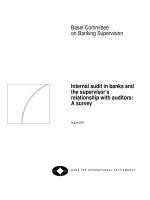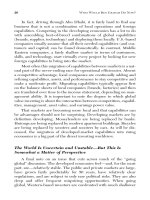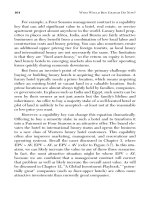Gone fishing with buffett a young man learns value investing from a mysterious old man
Bạn đang xem bản rút gọn của tài liệu. Xem và tải ngay bản đầy đủ của tài liệu tại đây (1.68 MB, 214 trang )
From the Author of
“Winning the Money Game”
Sean Seah Presents
Gone Fishing
With Buffett
i
CONTENTS
INTRODUCTION ............................................................................................................................................. IV
PART 1: ............................................................................................................................................................1
THE BAIT ..........................................................................................................................................................1
DOWN ................................................................................................................................................................ 2
CAN’T BEAT THE MARKET ................................................................................................................................... 5
TRAINING FLEAS ................................................................................................................................................. 9
HOLY GRAIL....................................................................................................................................................... 18
THE HYPE, BITES................................................................................................................................................ 22
PART 2: .......................................................................................................................................................... 30
THE FISHERMAN ............................................................................................................................................ 30
HOPE ................................................................................................................................................................ 31
RULE #1............................................................................................................................................................. 36
RISK................................................................................................................................................................... 39
COMPOUND ..................................................................................................................................................... 46
PART 3: .......................................................................................................................................................... 55
GREAT BUSINESSES ........................................................................................................................................ 55
BUYING BUSINESSES ......................................................................................................................................... 56
THE RIGHT BUSINESSES .................................................................................................................................... 62
COMPETITION .................................................................................................................................................. 68
ADVANTAGE ..................................................................................................................................................... 73
DISCIPLINE ........................................................................................................................................................ 76
BATTLEFIELD ..................................................................................................................................................... 80
MONEY IN, MONEY OUT ................................................................................................................................... 89
BUSINESS TO BUSINESS (B2B) ........................................................................................................................... 94
TRACK RECORD ............................................................................................................................................... 108
PROFITS .......................................................................................................................................................... 115
IPOS ................................................................................................................................................................ 123
EFFICIENCY AND PROFITABILITY.............................................................................................................................. 126
CROSS CHECKING............................................................................................................................................ 131
HEALTH CHECK ............................................................................................................................................... 138
DANGER SIGNS ............................................................................................................................................... 143
PRICING POWER OF A BUSINESS..................................................................................................................... 150
THE HORSE OR THE JOCKEY? .......................................................................................................................... 154
PART 4: ........................................................................................................................................................ 159
SENSIBLE PRICE ............................................................................................................................................ 159
PRICE AND VALUE ........................................................................................................................................... 160
MR MARKET.................................................................................................................................................... 166
TARGET BUY PRICE ......................................................................................................................................... 174
TIMES TO SELL ................................................................................................................................................ 190
ii
PART 5: ........................................................................................................................................................ 195
APPLICATION ............................................................................................................................................... 195
TAKING ACTION .............................................................................................................................................. 196
THE PARTING .................................................................................................................................................. 199
BILLIONAIRE ................................................................................................................................................... 204
iii
INTRODUCTION
“Put your money to work!”
“Buy Assets!”
Even before I entered the business school as an undergraduate, I have heard
many of such advice. “Financial literacy” is becoming a popular term and
everyone I know seemed to have at least read “Rich Dad, Poor Dad”.
Thus, the idea of needing to invest is something that most people are familiar
with.
The question for most people would be “What assets do I buy and how do I get
started in investing?”
This book provides you my experience investing in the stock market. I have
chosen to take my younger brother, Samuel’s suggestion to write it in a story
form, because I see a strong value in stories.
iv
This book is a simple story about how a young man learnt to invest from a
successful old investor. I wrote it in a manner that if a friend comes up to me
and asked me to guide him to invest, I would assume the role of the old
investor and guide him through like he is the young investor.
So while reading this book, imagine that you are sitting beside me at the jetty,
facing the sea, or if you prefer, as if we are sitting down at a café. And as a
personal friend, I am there to share with you my all my experience from stock
market investing.
Some years back when I started venturing into the stock market, I experienced
and suffered losses that were the result of ignorance and greed. And in the
midst of all that, the concept and methods of Value Investing had been
introduced to me through a friend, but I took very little interest in it and placed
a small portion of my money to work via the ‘Buffet way’. This is because it
does not seem to be able to get me rich….. quick. To me, Value Investing
seemed slow and boring because I associated it to Warren Buffett. And in my
mind, Warren Buffett only became rich after decades of investing and I am not
willing to wait for such a long time.
It was only when I started comparing the results I have gotten from Value
Investing to the other methods I used, I was astonished how stable my returns
were and how little time I had actually spent using Value Investing.
v
I have trained hedge fund managers in Trading using Technical Analysis rather
than Value Investing and I have seen 100 different results from 100 different
traders. And sad to say, most of them do not make consistent profits. The key
word is “consistency”, as the results have proven themselves in Value
Investing.
Beside the stable returns and the little time needed, what I really like about
Value Investing is that it is highly duplicable, when one takes on the mindset of
buying businesses from the stock market instead of speculating and being
worried about the short term performance of the stock price.
I have embedded a bit of my personal story of how I fell in the early days of
venturing into the stock market and this is in the hope that those who have
gone though similar experience can relate to it and continue to invest. And for
those who have not experienced how vicious Mr Market can be, this book will
bring to your awareness how the stock market works I will like to encourage
you to first invest in yourself and gain the proper knowledge before diving into
the stock market for a ‘quick buck’.
At the end of some segments, I have included an ‘Author’s Note’ to share with
you some of my personal experiences or to explain some technical details.
These notes will help you better understand how to apply what you learn from
the segment.
vi
As in my previous book, I am open to receiving any feedback, questions and
sharing of your personal experiences, be it lessons or success stories.
To your dreams and God bless you,
Sean Seah
vii
Part 1:
The Bait
1
DOWN
Sean, a 26 year old young man, walked to the edge of the jetty and stopped.
He stared at the horizon blankly, “Why had all these happened to me? Why
didn’t I listen to Prof?”
“Most People cannot beat the Market, so don’t even Try!”
The words of Sean’s Professor hit him like a brick and his heart sank. The
memories of the time when he was a young undergraduate in one of the
Prestigious Business School replayed in this mind.
Back in school, Sean attentively copied notes in his Finance and Investing class.
He was second year in the university and Finance and Investing is by far his
favourite subject. His Professor was engaging, humorous and most
importantly, Sean felt: “At last, I am learning something that I can actually
use!” He had always been doubtful and sceptical about the education system.
“Well, I don’t remember the last time I used Pythagoras' Theorem for any
practical usage. But now, I am learning how to invest in the stock market and
make some money!”
2
Sean was an attentive student in Business School especially in the class of
Finance and Investing. He compiled notes and investment ideas from the
Professor and in his mind, he was going to use these ideas to invest and grow
rich once he graduated from the business school. All he needed was to find a
job that would pay him so that he could finance his investments.
At the end of final tutorial, the popular and well liked Professor received
standing ovation as his passionate teaching and humour made him stand apart
from most of the serious, boring tutors. He had won the hearts of the students.
He smiled widely and stood there enjoying the appreciation showered on him.
After the applause stopped and the echoes that trailed ended, he signalled for
silence and scanned around the classroom sternly. Then he delivered his
parting words, “Class! After all that I have taught you, I need to warn you.
Most People cannot beat the Market, so don’t even Try!” These words
boomed in Sean’s ears. He couldn’t believe what he was hearing. Probably to
most of his classmates who had taken notes just to pass the exams, these
words from the Professor meant very little. But for Sean, his orientation was
very different. He had learnt to invest and the amount of confidence he had
built over the past months was badly shaken. He felt puzzled and upset. But he
was not willing to let his hopes be dashed by a mere statement, even though it
came from someone with great credibility and strong academic background.
He decided to do some of his own research…..
3
4
CAN’T BEAT THE MARKET
“That is what Prof is trying to say.” Sean felt enlightened. He did some research
online and read books about the stock market. After his own intensive study,
he realised that his Professor was right after all. Statistics showed that most of
the professional fund managers have not been able to beat the market
consistently! Although different studies showed slightly different results,
almost all the studies found out that 70% of the funds managed by
professionals have not been able to beat the market over the long run.
With the advice of his Professor and the reinforcement from his studies, Sean
silently decided in his heart that he will avoid the stock market at all costs.
After all, if the professionals cannot beat the market, what made him think
that a small retail player like himself can do it?
5
Author’s Note:
I thought it is important at this point of time to explain what it means when my
Professor say that most people cannot beat the market.
The Market
Firstly, what is “The Market”?
There are times where we hear the news reporting that the Singapore stock
market is up by certain number of points or down by certain amount of points.
The market is commonly represented by Stock Market Indices.
There are quite a number of stock market indices and a stock market index is
computed with a combination of stocks, usually from different industries. For
example, in the US, there is an index known as the Standard and Poor’s 500
Index which is computed by combining 500 largest U.S Stocks. Each day, as
these 500 stocks’ prices change, their average movement is computed to
represent the US stock market.
This means that while some stock prices go up, some go down and some
remain unchanged, the index will account for all the movements and average it
to represent the market.
These indices serve as a benchmark for most fund managers.
There are several studies out there which state that most Professionally
Managed Funds (Mutual Funds, Hedge Funds, Unit Trusts), have not been able
to outperform these indices consistently over the years. The top performing
6
funds usually are not able to remain at the top. Their performance may beat
the market indices for one year, maybe two year, but in the long run, it seems
that the market always outperform most of these funds.
Buy The Market!
So if you want to buy into a managed fund, you may choose to think twice and
perhaps buying the market may be a better bet. There is the Exchange Traded
Funds (ETF) that tracks the Market Indices and mirror the performance of
these indices.
For example, you can buy the STI ETF to Track Singapore’s Market which is
represented by the Straits Times Index. Or you can buy SPY (known as the
Spider) to track US’s Market which is represented by the S&P 500 index.
The interesting thing about most of these ETF is that you do not even need to
play management fees as no one is really managing these funds. In the case of
managed funds, you have to pay management fee regardless whether you win
or lose money. That being said, you have to take note of the unavoidable fees
such the brokerage fees.
7
8
TRAINING FLEAS
After graduation, Sean found a good paying job. And even though he would
participate in the discussions regarding the stock market whenever his
colleagues talked about it, he could not bear to put a foot into the stock
market. After all, his Professor and his research told him that the chances of
him, an average person, beating the market was close to slim. His thoughts
were firm, “If even the professionals cannot do it, what makes me think a parttime investor like me can make any money from the stock market?”
By this time, he had started a family with the lady he loves and they have a
baby boy to feed. With a well paying job and many bills to pay, there was no
way he was going to risk any of his hard-earned money. In fact, whenever he
participated in discussions regarding the stock market, he would strongly
advised people to stay out! “Most People cannot beat the Market, so don’t
even Try!”
One fateful day, Sean and his colleagues were having lunch break and they
were discussing about the latest movers and shakers in the stock market.
Nearing the end of the conversation, Sean again, gave his peers the advice his
Professor gave him 4 years back, “By the way guys, Most People cannot beat
the Market, so don’t even Try!” His peers listened and nodded in agreement.
Sean was a figure of a successful young man and with a good academic
background from a prestigious business school, his words had credibility.
9
One of his friends, Suffian, was a seasoned investor. He noticed that all the rest
were agreeing to what Sean said, could not help himself and raised his voice
slightly in order to gain the attention of the group.
“You are right, Sean. MOST people cannot beat the market...”
Then, he paused to make sure everyone was listening before delivering his
punch line.
“Because… MOST people do not KNOW how to.”
“Oh, you sound pretty confident Suffian. Do YOU know how to?” Sean
challenged. Sean had grown strong in the belief that no one can beat the
market and he was not ready to drop this belief, especially this was coming
from someone who did not even have a Business Degree.
“Well, I guess results speak louder than words. If you guys don’t mind, I can
show you my brokerage account with all my trades. I started about 3 years
back.” Suffian offered.
That got the entire group excited. Most of them, like Sean, talked about the
stock market but had not even opened a brokerage account. So seeing a live
10
brokerage account to them was like introducing military tanks and weapons to
a group of young men.
“What does this figure mean?” Sean pointed to an amount that was displayed
on the screen.
“That is the amount I can take out from the brokerage account if I sell away all
my stock holdings right now.” Suffian explained.
“What?! You have a quarter of a million in your account?” Sean exclaimed,
obviously impressed.
“Yep, that’s right” Suffian replied in a casual tone.
“And how much did you started with and how long did you take for you to do
that?”
“As mentioned, I started 3 years back. And I started with about $40,000 which
was my entire savings.”
11
That was all Sean needed, a personal friend who showed him that it is possible
to beat the market. Suffian was only 25 years old back then and he had
accumulated about a quarter million from the stock market.
“How? How did you do it?” Sean pleaded Suffian to teach them.
With the remaining fifteen minutes, Suffian shared his experience and gave the
group a list of resources which included the Business Times, a few websites
and a few recommended books.
Sean spent the next few weeks consuming the resources given to him. In his
mind, he would devote the next few years of his life to becoming a stock
market expert so that he can beat the market and grow rich. He aimed to be a
millionaire… no, he will be a multi millionaire or even billionaire.
After reading though the resources, he still felt inadequate. He had opened up
a brokerage account and had funded the account with his money. He had also
approached Suffian a number of times to ask him for some more hints and to
show him the directions. But before he could ask further, Suffian left the job
and became a full time broker instead. Sean and his peers were not surprised.
Why would a young successful investor like Suffian stay and work for someone
else?
12
Even though Sean had not learnt anything explicit from Suffian, he learnt a
lesson that is far more important. He learnt that it is POSSIBLE to beat the
market, if you KNOW how to do it. It is one thing to read in the papers or books
that a person became rich through investing. It is a whole different feeling
when someone you know at a personal level does it before your eyes.
Sean was hungry for the knowledge of investing. He now knew that it could be
done, he just needed to find out how. He began his search for the legendary,
Holy Grail.
13
Author’s Note:
I once heard motivation speaker Zig Ziglar said that in order to reach your
goals, you have to be a Flea Trainer –hence the title of this segment, Fleas.
If you take a glass jar and put Fleas in it, you will be able to observe that they
will attempt to jump out of the jar. Hence, what you should do is to put the
cover on. What is interesting is that as you continue to observe the fleas, you
will see them continuously jumping and hitting onto the ‘ceiling’, which is the
jar cover. You can either continue to stare at them for 30min or you can go and
carry on your work and come back 30min later, but what will happen 30min
later is astonishing!
30min later, when you return to look at the jar, you will see that the fleas will
still be jumping. But they will no longer be hitting the ceiling. In fact they will
jump to a height that is just below the ceiling. At this point of time, you can
remove the cover of the jar and guess what? The fleas will continue to jump
hard, but they will never jump out of the jar. They have been conditioned to
believe that there is a ceiling and they will not be able to jump out!
How many of us still believe that there is ‘ceiling’? What my professor did for
me was to place a ‘ceiling’, or a limiting belief in my mind. I reinforced it with
my research. And because of that, I never dared to invest in the stock market
because I was conditioned to believe that it cannot be done.
Meeting Suffian was an important part of my life, because what he did for me
was to ‘break my jar’ and free me from my limiting beliefs.
14
What are your beliefs about the stock market? What are your beliefs about
making money from the stock market?
I used to believe that the stock market is not a place for me to venture into and
that investing is gambling.
In order for you to become a better investor, it is important for you to take
stock of yourself, and notice what is helping you and what is stopping you.
For e.g., my belief that to invest in the stock market is a form of gambling
stopped me from even trying to understand how it is possible to invest
properly. That did not help me as an investor.
And interestingly, I found out that whenever you go and look for evidence to
support your belief, you will usually find them. Just like when I went to find
out if it is true that most people cannot beat the market, I find many evidences
that it is true.
After I met Suffian, I began to realise that while it is true that most people
cannot beat the market, it is also true that there are also many who
consistently beat the market because they used proven methodology that
makes so much sense. I guess, whatever you choose to believe, you will be able
to find some sort of evidence to back yourself up. So choose your beliefs
wisely. Choose those that empower you, not those that dis-empower you.
15
16
17
HOLY GRAIL
[Proven Trading System that Makes You $10,000 your first month!]
[I sacked my boss and trade full time after attending XXX’s course]
[Using this Proven System, we have the most full time traders who quitted
their jobs.]
“Wow! I wonder which course I should attend. There are so many of them out
there!”
Sean was looking through the newspapers and surfing the web for a course he
could attend. He needed someone to teach him and he decided to learn from
someone credible, someone who had ‘been there, done that’. He wanted to
cut short his learning curve and make a million within the shortest time. After
all, Suffian made his quarter million within 3 years.
He started attending Stock Market Courses’ workshop previews and decided
on a Trading course which cost $5,000, taught by a self made millionaire who
made his millions in the stock market using a secret system.
18









